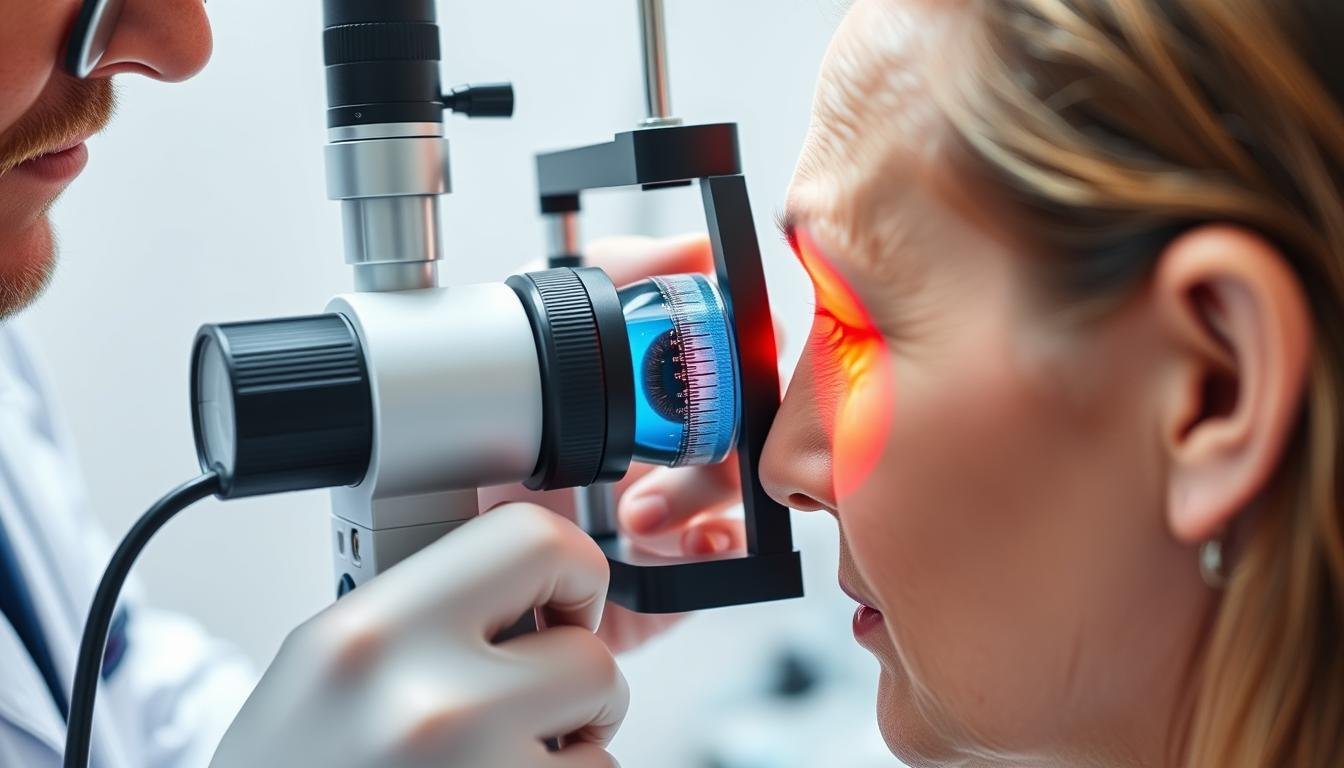When it comes to alternative health practices, few are as visually intriguing as Iridológia. This practice suggests that the iris—the colored part of your eye—contains a detailed map of your body’s health. Proponents claim that by examining patterns, colors, and other characteristics in your iris, practitioners can identify health issues before symptoms appear. But how much of this is scientifically supported, and how much remains unproven? This comprehensive guide explores the myths and facts surrounding Iridológia, helping you understand what this practice can and cannot tell you about your health.What Is Iridológia and How Does It Work?

An iridologist examining a patient’s iris using specialized equipment
Iridológia is the study of the iris to identify potential health concerns throughout the body. Practitioners believe that each area of the iris corresponds to different organs and body systems. When examining the iris, iridologists look for various markings, colors, and patterns that may indicate inflammation, toxin buildup, or other health issues in corresponding body parts.
História Iridológia
Pôvod Iridológia are often traced back to Ignaz von Peczely, a Hungarian physician who, in the 1860s, noticed changes in an owl’s iris after the bird suffered a broken leg. This observation led him to develop the theory that changes in the iris could reflect health conditions elsewhere in the body. Von Peczely later created one of the first iris charts mapping different regions of the iris to various body parts.
V 50. rokoch 20. storočia sa ďalej rozvinul americký chiropraktik Bernard Jensen Iridológia by creating a more detailed iris chart that is still widely used today. Jensen believed that the iris could reveal not only current health conditions but also hereditary predispositions and past health issues.
How an Iridológia Examination Works



Standard iridology chart mapping iris regions to body systems
During an Iridológia session, a practitioner uses specialized tools to examine your iris in detail. These tools typically include:
- Magnifying devices or specialized cameras
- Bright lights to illuminate the iris
- Iris charts for reference and interpretation
- Digital imaging technology (in modern practices)
The iridologist looks for specific signs in your iris, such as:
- Farebné variácie a zmeny pigmentácie
- Dark spots or flecks
- White or cloudy areas
- Rings or circles around the iris
- Lines or “spokes” radiating from the pupil
These findings are then compared to an Iridológia chart, which divides the iris into approximately 60 zones, each corresponding to different parts of the body. For example, the top section of the iris might represent the brain and head, while the lower sections might correspond to the digestive system or legs.
Ten Iridológia Chart Explained
A Iridológia chart is essentially a map that divides the iris into zones corresponding to different body parts and systems. The left iris is generally associated with the left side of the body, and the right iris with the right side. The chart typically follows a clock-like pattern, with each “hodina” position representing different organs or body systems.
Tu je podrobnejšie informácie o poruche a systémoch predstavovaných každým okom. Tieto grafy slúžia užitočnému sprievodcovi, ktorí identifikujú obavy na základe korešpondenčných iridologických znakov.

Iridologické grafy ľavé oko (predstavuje ľavé bočné telo)
| Poloha v iridológii | Oblasť tela/orgán zodpovedá | Kľúčové ukazovatele zdravia | Možné problémy alebo nerovnováhy |
|---|
| 12 hodín | Ľavý mozog (psychologické) | Duševné zdravie, emocionálny stav | Stres, úzkosť, depresia, duševné vyčerpanie |
| 1-2 | Ľavá tvár/krk | Zdravie kože, napätie v svaloch krku | Migrény, bolesť krku, poruchy TMJ, sínusové problémy |
| 2-3 | Vľavo | Funkcia dýchacích a hrdla | Bolesť v krku, chrapot, dýchacie infekcie |
| 3-4 hodín | Ľavý horný chrbát | Zdravie chrbtice, horné chrbtové a ramenné svaly | Horné zadné napätie, bolesť ramien, zlé držanie tela |
| 4-5 hodín | Ľavý žalúdok | Tráviace funkcie, produkcia kyseliny | Žalúdočné vredy, trávenie, nízka žalúdočná kyselina |
| 5-6 hodín | Ľavá panvová oblasť | Reprodukčné orgány, močový systém | Menštruačné problémy, infekcie močových ciest, bolesť panvy |
| 6-7 hodín | Ľavá spodná časť chrbta/nohy | Muskuloskeletálne zdravie, obeh nôh | Ischias, problémy s bedrami, bolesť dolnej časti chrbta, kŕče nôh |
| 7-8 hodín | Ľavá oblička | Funkcia obličiek a moču | Obličkové kamene, problémy s močovým mechúrom, zadržiavanie vody |
| 8-9 hodín | Ľavé pľúca | Respiračné zdravie, pľúcna kapacita | Astma, chronická bronchitída, dýchavý dýchanie |
| 9-10 hodín | Ľavé srdce | Kardiovaskulárny systém, emocionálny studň | Srdcové choroby, bolesť na hrudníku, obehové problémy |
| 10-11 hodín | Ľavé tráviace orgány | Zdravie tráviaceho systému | Zápcha, flow, zlé trávenie, funkcia pečene |
| 11-12 hodín | Ľavá pankreas/slezina | Regulácia cukru v krvi, imunitné zdravie | Cukrovka, hypoglykémia, problémy s trávením, autoimunitné problémy |

Iridologická tabuľka pravého oka (predstavuje pravú stranu tela)
| Poloha v iridológii | Oblasť tela/orgán zodpovedá | Kľúčové ukazovatele zdravia | Možné problémy alebo nerovnováhy |
|---|
| 12 hodín | Pravý mozog (psychologický) | Kognitívne zdravie, duševná jasnosť | Kognitívny pokles, duševná únava, stres |
| 1-2 | Pravá tvár/krk | Zdravie pokožky, napätie na pravej strane krku | Bolesť čeľuste, tenzné bolesti hlavy, problémy s dutinami |
| 2-3 | Pravé hrdlo | Zdravie pravých pľúc, štítnej žľazy a hrdla | Bolesť hrdla, kašeľ, chrapot, nerovnováha štítnej žľazy |
| 3-4 hodín | Pravá horná časť chrbta | Zdravie hornej časti chrbtice, ramien a pľúc | Napätie v ramenách, dýchacie problémy, bolesť v hornej časti chrbta |
| 4-5 hodín | Pravý žalúdok | Problémy s trávením, tvorba žalúdočnej kyseliny | Pálenie záhy, žalúdočné vredy, poruchy trávenia |
| 5-6 hodín | Pravá panvová oblasť | Reprodukčné orgány, pravá oblička, močový systém | Problémy s prostatou, menštruačné problémy, infekcie močových ciest |
| 6-7 hodín | Pravá spodná časť chrbta/nohy | Cirkulácia, zdravie pohybového aparátu | Ischias, svalové kŕče, problémy s obehom nôh |
| 7-8 hodín | Pravá oblička | Funkcia obličiek, zadržiavanie tekutín | Ochorenie obličiek, infekcie močových ciest, dehydratácia |
| 8-9 hodín | Pravé pľúca | Zdravie dýchania, funkcia pľúc | Bronchitída, astma, chronická obštrukčná choroba pľúc |
| 9-10 hodín | Pravé srdce | Kardiovaskulárne zdravie, funkcia srdca | Hypertenzia, srdcové choroby, emočný stres |
| 10-11 hodín | Pravé tráviace orgány | Trávenie a vstrebávanie živín | Zápcha, IBS, problémy s pečeňou, zlé trávenie |
| 11-12 hodín | Pravý pankreas/slezina | Imunitný systém, regulácia cukru v krvi | Cukrovka, slabosť imunitného systému, poruchy trávenia |
Top 10 Myths About Iridológia Debunked

Modern medical diagnostics compared to iridology examination tools
Despite its popularity in some alternative health circles, Iridológia has been surrounded by numerous misconceptions. Let’s examine and clarify some of the most common myths:
Myth 1: Iridológia Can Diagnose Specific Diseases
“Iridology cannot diagnose specific diseases. It can only indicate potential areas of weakness or stress in the body.”
— Dr. Bernard Jensen, considered the father of modern Iridology
Fact: Iridológia cannot diagnose specific diseases like cancer, diabetes, or heart disease. While practitioners may identify signs of stress or weakness in body systems, these observations cannot replace proper medical diagnosis. Scientific studies have consistently failed to show that iridologists can accurately identify specific diseases through iris examination.
Myth 2: The Iris Changes Regularly to Reflect Current Health Status
Fact: The basic structure and pattern of the iris remain relatively stable throughout life. While some subtle changes may occur due to aging or injury, the iris does not continuously change to reflect day-to-day health status. This stability is why iris scans are used for biometric identification—they remain consistent over time.
Myth 3: Iridológia Is an Ancient Medical Practice
Fact: While some claim Iridológia dates back thousands of years to ancient Egypt or China, modern Iridológia as we know it today only emerged in the 19th century with Ignaz von Peczely’s work. There is limited historical evidence of systematic iris analysis before this time.

Ignaz von Peczely, founder of modern iridology (1826-1911)
Myth 4: Iridológia Is Scientifically Proven
Fact: Most scientific studies have not supported the claims made by Iridológia. A 1979 study published in the Journal of the American Medical Association found that iridologists could not accurately detect gallbladder disease through iris examination. Similar studies have shown that iridologists cannot reliably identify conditions like cancer, kidney disease, or other ailments.
Myth 5: All Iridológia Practitioners Use the Same System
Fact: There are multiple schools of thought within Iridológia, each with different approaches and interpretations. Some practitioners follow Bernard Jensen’s system, while others adhere to European methods or more modern approaches. This lack of standardization can lead to different conclusions from different practitioners examining the same iris.
Test Your Iridology Knowledge
Think you understand the basics of iridology? Take our interactive quiz to test your knowledge and learn more about this fascinating practice.
Take Our Iridology Quiz
Myth 6: Iridológia Can Predict Future Health Problems
Fact: While some practitioners claim Iridológia can predict future health issues, there is no scientific evidence supporting this claim. The iris does not contain information about future health events that have not yet occurred or developed in the body.
Myth 7: Iridológia Can Replace Regular Medical Check-ups
Fact: Iridológia should never replace regular medical check-ups or diagnostic tests. Even practitioners who believe in the value of Iridológia typically recommend it as a complementary approach, not a replacement for conventional medical care.
Myth 8: Iridológia Is Completely Harmless
Fact: While the examination itself is non-invasive and physically harmless, relying solely on Iridológia for health assessments could potentially delay proper medical diagnosis and treatment of serious conditions. This indirect harm is the primary concern of medical professionals regarding Iridológia.
Myth 9: Eye Color Changes Indicate Health Changes
Fact: Natural eye color is determined by genetics and generally remains stable throughout life. Minor variations in perceived eye color may occur due to lighting, pupil dilation, or surrounding colors, but these do not indicate health changes as claimed by some Iridológia practitioners.
Myth 10: A Ring Around the Iris Always Indicates High Blood Pressure
Fact: A white or grayish ring around the iris (arcus senilis) is often a normal age-related change caused by lipid deposits. While it can sometimes be associated with high cholesterol in younger people, it is not a reliable indicator of high blood pressure as claimed by some iridologists.

Arcus senilis: A white ring around the iris often mistakenly associated with high blood pressure
Evidence-Based Facts About Iridológia
While many claims about Iridológia lack scientific support, there are some evidence-based facts worth considering:

Scientific research on iris patterns and their potential health correlations
Fact 1: The Iris Does Contain Unique Biological Information
The iris contains unique patterns that are genetically determined and remain relatively stable throughout life. This uniqueness is why iris scans are used for biometric identification. While this doesn’t validate health diagnosis claims, it does confirm that the iris contains complex biological information.
Fact 2: Some Eye Changes Can Indicate Health Issues
Certain changes in the eye—though not necessarily in the iris—can indicate health problems. For example, yellowing of the whites of the eyes (sclera) can indicate liver problems, and visible blood vessels might suggest hypertension. However, these observations are part of conventional medical examination, not unique to Iridológia.
Fact 3: Iridológia Examinations Are Non-Invasive
One legitimate advantage of Iridológia is that it is completely non-invasive. The examination involves only visual inspection of the iris, with no physical discomfort or risk to the patient.
| Actual Eye Sign | Potenciálna indikácia zdravia | Medical Validity |
| Yellowing of sclera (whites) | Liver issues, jaundice | Medically validated |
| Bulging eyes | Thyroid issues (Graves’ disease) | Medically validated |
| Viditeľné krvné cievy | Hypertension, inflammation | Partially validated |
| Arcus senilis (ring around iris) | Age-related change, sometimes high cholesterol | Partially validated |
| Iris color patterns | Organ dysfunction (iridology claim) | Not scientifically validated |
Fact 4: Iridológia May Have Psychological Benefits
Some people find value in Iridológia consultations because they involve detailed discussions about health and lifestyle. This holistic approach and personal attention may provide psychological benefits, even if the specific iris-based assessments lack scientific validity.
Fact 5: Research on Iridológia Is Limited
While most existing studies have not supported Iridológia‘s claims, the total body of research is relatively small. Some proponents argue that more research using modern technology and standardized methods might yield different results.

Modern digital iridology analysis using specialized software
Practical Applications of Iridológia Today
Despite scientific skepticism, Iridológia continues to be practiced worldwide. Here’s how it’s commonly applied today:
Complementary Health Assessment
Many practitioners use Iridológia as one component of a broader holistic health assessment. Rather than diagnosing specific diseases, they use iris analysis to identify potential areas of weakness that might benefit from lifestyle changes or nutritional support.

Holistic health consultation incorporating iridology findings
Personalized Wellness Plans
Some nutritionists and naturopaths use Iridológia as a tool to develop personalized wellness plans. They may recommend specific dietary changes, supplements, or lifestyle modifications based on their interpretation of iris signs.
Vzdelávací nástroj
Iridológia is sometimes used as an educational tool to help people visualize and understand the interconnectedness of body systems. The iris map can serve as a visual reference for discussing how different organs and systems affect overall health.
Moderný Iridológia Technologies
Tradičný Iridológia has evolved with technology. Modern practitioners often use digital cameras and specialized software to capture and analyze iris images, allowing for more detailed examination and record-keeping.
Expand Your Knowledge
Join our upcoming webinar where experts discuss the historical development of iridology and its place in modern complementary medicine.
Register for Iridology Webinar
Limitations of Iridológia in Practice
Even practitioners who value Iridológia acknowledge its limitations:
Potenciálne výhody
- Neinvazívne hodnotenie
- May identify areas of constitutional weakness
- Can encourage preventive health measures
- Provides a holistic perspective
- May complement other health assessments
Recognized Limitations
- Cannot diagnose specific diseases
- Lacks scientific validation
- Interpretations vary between practitioners
- Nemalo by nahradiť lekársku diagnózu
- May lead to unnecessary treatments

Discussing iridology findings with a conventional medical doctor
Často kladené otázky o Iridológia
Is Iridology scientifically proven?
No, Iridológia is not scientifically proven. Most scientific studies have failed to demonstrate that iridologists can accurately diagnose health conditions through iris examination. A notable study published in the Journal of the American Medical Association found that iridologists could not detect gallbladder disease from photographs of irises. However, research in this field is limited, and some practitioners argue that more studies using standardized methods are needed.
Can Iridology detect cancer?
There is no scientific evidence that Iridológia can detect cancer. A study published in the Journal of Cancer Research and Clinical Oncology found that iridologists could not reliably identify patients with cancer by examining their irises. Medical professionals strongly advise against using Iridológia as a cancer screening tool and recommend conventional medical screening methods instead.
How much does an Iridology session cost?
The cost of an Iridológia session varies widely depending on location, practitioner experience, and session length. Typically, sessions range from to 0. Some practitioners include Iridológia as part of a broader naturopathic or holistic health consultation, which may affect the overall cost.
Can Iridology help with preventive healthcare?
Proponents suggest that Iridológia may help identify areas of weakness before symptoms develop, potentially allowing for preventive measures. However, there is limited scientific evidence supporting this claim. If you’re interested in preventive healthcare, consider evidence-based approaches such as regular medical check-ups, healthy diet, regular exercise, and stress management alongside any complementary approaches.
Do iris patterns change with health conditions?
The fundamental structure and pattern of the iris remain relatively stable throughout life. While Iridológia practitioners claim to observe changes that correspond to health conditions, scientific evidence does not support the notion that the iris regularly changes to reflect health status. Some visible changes in the eye (though not necessarily the iris) can indicate health issues, but these are generally recognized by conventional medicine as well.

Various iris patterns and colors studied in iridology
The Bottom Line on Iridológia

Making informed decisions about incorporating iridology into health practices
Iridológia remains a controversial practice in the health world. While scientific evidence does not currently support many of its claims, some people find value in its holistic approach to health assessment. If you’re interested in exploring Iridológia, consider these balanced recommendations:
- Approach Iridológia as a complementary tool, not a replacement for conventional medical care
- Consult with qualified healthcare providers for any health concerns
- Be skeptical of practitioners who claim to diagnose specific diseases through iris examination alone
- Consider the psychological and holistic benefits that might come from the process, regardless of the specific iris analysis
- Stay informed about both traditional and complementary approaches to health
Whether you view Iridológia as a fascinating alternative perspective or remain skeptical of its claims, understanding both the myths and facts can help you make informed decisions about your health care approach. The eyes may indeed be windows to many things—but the extent to which they reveal our health remains a subject of ongoing debate.















